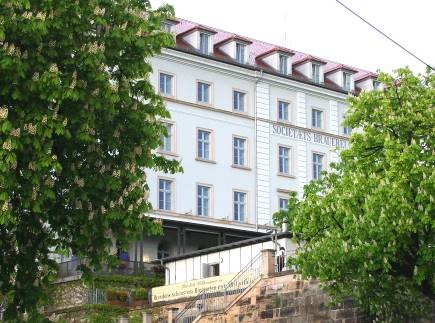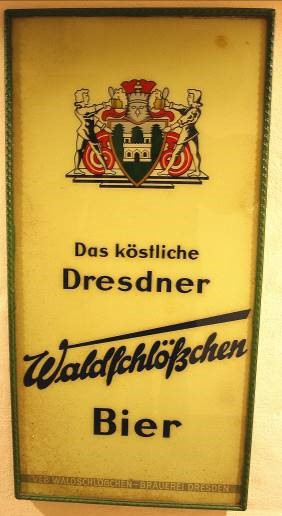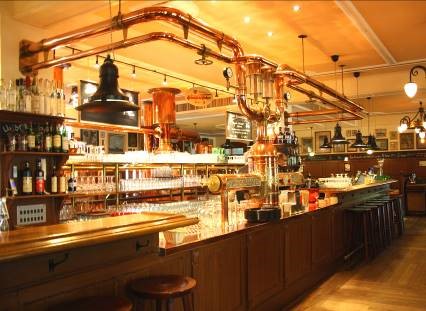 Friday 11th April 2014
Friday 11th April 2014
Bob Thompson
This huge brew pub describes itself as Dresden's most beautiful brew house. A description that is difficult to dispute when you are on the front terrace looking back at the Altstadt (Old Town) with the River Elbe in the foreground. It has some history as the magnificent building was once the part of Brauerei Waldschlösschen, which goes back to the 19th century.
 Its story begins with Count Marcolni who was an important person in late 18th century Saxony. He was influential and had the ear of the Elector, Augustus III. Around about 1790 he built a hunting lodge in the hills overlooking a bend in the River Elbe. Now, these hunting lodges were not a kind of wooden cabin you'd expect to see today. This example was the first building in Saxony to be constructed in the Neo-Gothic style.
Its story begins with Count Marcolni who was an important person in late 18th century Saxony. He was influential and had the ear of the Elector, Augustus III. Around about 1790 he built a hunting lodge in the hills overlooking a bend in the River Elbe. Now, these hunting lodges were not a kind of wooden cabin you'd expect to see today. This example was the first building in Saxony to be constructed in the Neo-Gothic style.
The structure is still with us today, hidden behind the brew pub's building. In 1829 it was converted into a tavern.
 A joint-stock company was set up in 1836 by some of the prosperous residents of the Preussisches Viertel, (Prussian Quarter), the district that leads up to Waldschlösschen when coming from the city. It and most of its opulent villas are still extant as I observed from the tram on my way to the brew pub.
A joint-stock company was set up in 1836 by some of the prosperous residents of the Preussisches Viertel, (Prussian Quarter), the district that leads up to Waldschlösschen when coming from the city. It and most of its opulent villas are still extant as I observed from the tram on my way to the brew pub.
The purpose of the company was to build a brewery and this was duly completed and started production in 1837. A malt house was added in 1838 and this completed the construction period. The grand opening was held on 26th March 1838, and the citizens of Dresden really took to the new brewery, consuming 6 hl (6,000 litres) of beer on that day alone.
In 1857 most of it burnt down and a new brewery was constructed and I guess the buildings with us today date from this time. In those days the company boasted that it brewed Bavarian style beers. So well regarded were their products that they began exporting to Brazil in 1855 and Paris from 1863. Up to the end of the 19th century there were many more buildings added to the complex. In 1888 it was renamed Societätsbrauerei, although Waldschlösschen remained the brand name.
All continued well with the exception of the two wars. The brewery survived the bombing of the Second World War with not too much damage. However it was nationalised in 1946, relatively early.
 In due course it had VEB added to its title, indicating its state ownership. Nevertheless it continued trading independently. This changed in 1960 when it became a part of VEB Dresdener Brauerein (Dresden Breweries) and was know as Werk Nord (North Factory, and you don't get any more impersonal than that!).
In due course it had VEB added to its title, indicating its state ownership. Nevertheless it continued trading independently. This changed in 1960 when it became a part of VEB Dresdener Brauerein (Dresden Breweries) and was know as Werk Nord (North Factory, and you don't get any more impersonal than that!).
From 1978 to 1984 it changed again as it was then known as VEB Waldschlösschenbrauerei, yet was within the VE Getränkekombinat Dresden (State Drinks Collective of Dresden).
 You can sense the every increasing centralisation of the breweries and soft drinks trade as the state took more and more control. For this brewery the end was in sight as beer production ceased in 1984, it made only soft drinks after that.
You can sense the every increasing centralisation of the breweries and soft drinks trade as the state took more and more control. For this brewery the end was in sight as beer production ceased in 1984, it made only soft drinks after that.
The main reason for its closure can be attributed to the move of the Feldschlösschen brewery from its old brewery to a massive new facility at Dresden-Coschütz in 1981. Its construction eventually saw off all of the other three large city breweries.
 Even the production of soft drinks at Waldschlösschen finished in 1990 with re-unification, as it would have be unable to compete with multi-national brands flooding in.
Even the production of soft drinks at Waldschlösschen finished in 1990 with re-unification, as it would have be unable to compete with multi-national brands flooding in.
The final chapter begins in 1992 when a loan is obtained for the reconstruction of the brewery complex. I don't know this, but it would be nice if this was granted to the original owners and successors, i.e. prior to 1946. I think that nearly all property was restored to the original owners after 1990.
It finally opens with a brewery installed in 1997. More work needed to be done and this was finished in 2005. There is now a hotel on site; it must be a nice place to stay.
I climbed the many steps from the tram stop before reaching the terrace in front of the building. At this point it is possible to take in the extensive view. In front of the main entrance there is a strange but beautiful fountain.
 It is the type where the water overflows each level on to the one below; there are seven in all. It provides passing birds with a cold drink and to encourage them to stop are a number of stone birds drinking sculptured into it. These are strange as they appear to have the bodies of pigeons but the heads of toucans.
It is the type where the water overflows each level on to the one below; there are seven in all. It provides passing birds with a cold drink and to encourage them to stop are a number of stone birds drinking sculptured into it. These are strange as they appear to have the bodies of pigeons but the heads of toucans.
Once in through the front door the full extent of this pub became immediately obvious. There was a "meeter and greeter" on the door and when I said I was only there for a beer she directed me towards some tall tables with stools near the bar which also had stools. Although this situation seems a bit alien to us beer drinking non-diners, it is absolutely essential here as those with reservation haven't a clue where to find their table and those without do not know which places are free.
The aforementioned bar is to the right of the entrance door and is very long. Behind it is brewery itself, all gleaming copper. I looked the other way at the expansive dining area. The room's walls are of wood panelling to around head height and above that many old photographs and paintings are displayed. The facilities are on a lower level and are reached by a staircase immediately in front of the brewery. On the way down there are several old enamel advertisements to admire.
There are four regular beers and these are: Original (5.0%), hell (pale) lager; Zwickelbier (5.5%), an unfiltered stronger version of Original; Dunkel (5.5%) a dark beer and Hefeweizen (5.5%) (wheat beer).
 There are several seasonal beers such as Maibock (6.5%); Sommerbier, a hoppy beer for the warmer months and Weihnachtsbier, a very interesting Christmas beer that is made with smoked malt.
There are several seasonal beers such as Maibock (6.5%); Sommerbier, a hoppy beer for the warmer months and Weihnachtsbier, a very interesting Christmas beer that is made with smoked malt.
I had the Dunkel and I loved it, almost the perfect example of the style with just the right balance of malt with hops. I followed it with the Original which was fine, although I wish I had consumed them in the reverse order, yet how would I have known that the Dunkel would be so good?
When I left the pub I decided to would walk to the tram stop by a longer route to avoid the steps and who did I find? Our old friend King Gambrinus, yet again! The King of beer was displaying himself in a bas-relief stone carving set in a kind of hollow in the wall. He is holding his glass up in the classic salutary pose whilst his man servant is tapping his next one from the barrel on which rests his left arm.
This is a very good brew-pub-restaurant that is easily reached from Dresden city centre.
Important Information:
Brauhaus am Waldschlösschen, Am Brauhaus 8b, Dresden Radeberger-Vorstadt 01099
Tel: 0351 652 3900
Open: Monday-Sunday 11.00-01.00
The pub has its own tram and bus stop. So you can alight from the no 11 tram at the Waldschlösschen stop. This comes from the main station, then through both the Altstadt and Neustadt and runs every ten minutes. It is also served by the round-city bus route 64, the Park & Ride route 74 and the infrequent 261 bus.
